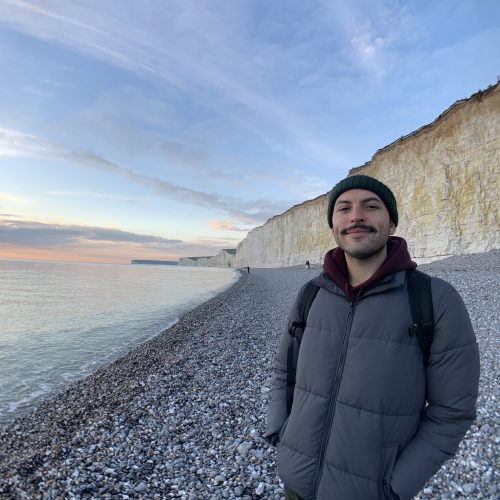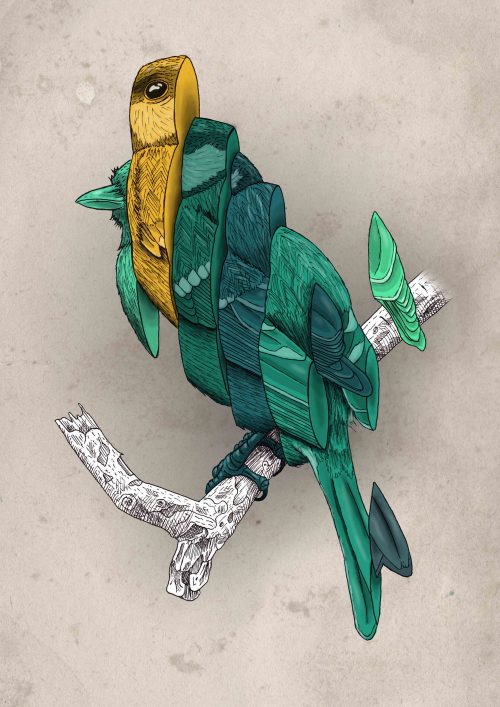SciArt profile: Giacomo Moggioli
Posted by the Node, on 15 October 2021
Our twelfth SciArt profile of the series features Giacomo Moggioli, a PhD student at Queen Mary University of London studying genomics of deep sea worms

Where are you originally from and what do you work on now?
I am from Milan, Italy. I did both my bachelor’s and master’s degrees at University of Milan-Bicocca. During my years as undergraduate student I started to feel fascinated by deep sea environments, so I decided to apply for the Erasmus project and spend one year working on my master’s thesis at Heinrich-Heine University in Düsseldorf. My thesis was focused on the role of iron-sulphur clusters in the origin of life, which, accordingly to the most robust hypothesis, happened in hydrothermal vents environments. My curiosity for this kind of deep-sea environments motivated me to apply for a PhD at Queen Mary University of London. Now, as a PhD student, I work on a fascinating clade of Annelid worms, Siboglinidae, which thrive in hydrothermal vents. I love to be able to learn more and more about these creatures. They possess such unique features such as the lack of a digestive system in favour of a symbiotic lifestyle that allows them to harness the energy contained in sulphur compounds in order to keep their metabolism going.

I made this for an Art and Science contest organized by the university of Milan-Bicocca and it has been exhibited at the Natural History Museum of Milan. I have tried to shape the tree of life as the portrait of the famous scientist. The origin of life is at the tip of the beard and from there you can follow the evolution organism by organism upward. Plants, animals, fungi, invertebrates, I have simply tried to put as many different organisms as possible. Can you spot the Koala?
Were you always going to be a scientist?
Not at all. I believe that what happens in our lives keep on shaping our desires, aspirations and interests, so I don’t feel I ever had a clear path ahead of me. Nevertheless, when I was a little kid I was fascinated about being a marine biologist, and here I am today! Over the years I had many different part-time jobs, for example I was working in a flower shop for a couple of years during University, I worked at a stand during design week promoting some very nice lamps and I have also worked in a motorbike customisation shop, where I was mainly painting on helmets and bikes. So I definitely had the opportunity to try different paths, but overall the part time job I loved the most during my time in Milan was being a freelance illustrator. As an illustrator I was taking part in art fairs, art markets and exhibitions all over Italy showing my art and selling my prints. I am happy where I am now, working with deep sea animals in London, but I definitely considered making a living out of my illustrations.

This is part of a project on Japanese spirits, my idea is to make a sort of an encyclopedia about the many different “Kami” or spirits that are coming from the Shintoism. This ancient animistic religion believes every natural and even artificial entity has its own soul, its own spirit. I have expanded this concept and started to imagine how these spirits might look.
And what about art – have you always enjoyed it?
Yes, as far as I can remember. When I was a kid my mother was buying me awesome illustrated books about sea animals. I was spending hours looking at those beautiful drawings of all the amazing life forms we can find in our oceans! I always tell my friends that those books made me who I am today, having marine biology and illustration as the main passions in my life. I am very grateful to have had the opportunity to study art history at high school. In those classes I learnt a lot about artists and understand how they made their art and what they wanted to say with what they were doing. I really feel there is a world behind every single art piece we see; a world made by the experiences of the artists and their opinions, ideas and way of looking at the world. This feeling really enhanced my curiosity about Art. Now I really enjoy going to art museums and exhibitions and when I am walking around the city, I always love to search for street art, murals and graffiti, trying to imagine the world that might be behind them.
“I really feel there is a world behind every single art piece we see; a world made by the experiences of the artists and their opinions, ideas and way of looking at the world.”

Another artwork from my Kami series.
What or who are your most important artistic influences?
There were many amazing artists that impacted me and there will always be new ones as well. To name just a few of them: Salvador Dalí, who showed me that the only limit in art is our imagination, an Italian street artist named “Blu”, his rich and meaningful works taught me to always keep an eye open for hidden beauty that always surround us, Masashi Kishimoto, the author of the manga “Naruto” from which I understood the artistic potentiality of a black outline, and finally another Italian street artist “Hitnes”, from which I have learnt the artistic potentiality of not using a black outline.

I am really fascinated by birds and I love to play with their shapes and their colours and see the final result!
How do you make your art?
When I was living in Milan I had a studio and this allowed me to try many different techniques. After these experiments, I managed to find a technique which I felt comfortable with. I was first drawing with pencil on paper, then inking the lines with a black marker, erase the pencil away and finally color the drawing with alcohol-based markers which allowed a very good control of the shades. Then I move to London, and I couldn’t carry my studio with me. Therefore, I decided to switch to digital techniques and now I am mainly working using my tablet and a drawing app. After a steep learning curve, I now feel comfortable drawing with my tablet and I love to be able to draw from my sofa instead of sitting on a desk fully covered in ink and all sort of different drawing tools.

Primates all together are forming a human face. When making this composition I always like to depict different interactions between the characters. Can you spot the monkey trying to steal the baboon’s banana?
Does your art influence your science at all, or are they separate worlds?
I would say that science is influencing my art more than the other way around. I love to make science-inspired drawing, but I have never really done art-inspired science before. Nonetheless, I think that art may indirectly influence my science. While doing my art I have learnt how to transform big, complicated and very detailed subjects into some way simpler yet still very descriptive drawings. I find this “simplification process” I use in my art to be very useful in science as well. As a scientist a big part of my work is handling huge amounts of genomic data and identity the key features in order to be able to simplify the information and make a good description of the organism I am studying.

This is part of my icon-like animal series, heavily inspired by the British illustrator Owen Davey. I have started to make these icons and share them with my colleagues so that they could include them in their slides and hopefully have a nice simple representation of the organisms there are studying.
What are you thinking of working on next?
At the moment, my priority is completing my PhD and publish my first paper as first author on deep sea worm genomics. After that I would like to keep on working with marine organism genomics in a Postdoc. As a side artistic project, I have started to work on a card game during the long lockdown evenings and I would like to finish the last details and try to release it to the public. Little spoiler: there will not be deep sea creatures but there will be some dinosaurs in my game 😊.

This vintage-like dinosaur toy will be part of my upcoming card game. Stay tuned!
If you want to have a look at my other works and be updated on my new projects you can follow me on Instagram: https://www.instagram.com/kelp_art/
We’re looking for new people to feature in this series – whatever kind of art you do, from sculpture to embroidery to music to drawing, if you want to share it with the community just email thenode@biologists.com (nominations are also welcome!)


 (3 votes)
(3 votes)